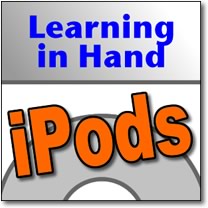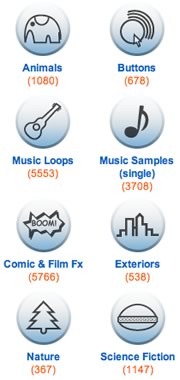 I Didn't Know You Could Do That with an iPod was the name of a session I presented at last month's National Educational Computing Conference in Atlanta. The room was pretty much full when I entered to set up. By the time the session started, people were crammed in every square foot of space. In fact, blogger David Jakes gave his Most Ironic award to the fact that there was "so much interest in the educational application of a tool that is banned in most schools."
I Didn't Know You Could Do That with an iPod was the name of a session I presented at last month's National Educational Computing Conference in Atlanta. The room was pretty much full when I entered to set up. By the time the session started, people were crammed in every square foot of space. In fact, blogger David Jakes gave his Most Ironic award to the fact that there was "so much interest in the educational application of a tool that is banned in most schools."
Kyle Stevens took great notes during the session. You can read his notes and listen to a recording on his Final Curve blog.
I used an iPod as a fun way to give away a prize. One of the possible prizes was an iPod Key Chain Connector. Lots of attendees wanted more information on the connector, so I wrote about it here.
 I got many questions for more information about the camera I was using to show the iPod's screen. Unlike Palm handhelds and Pocket PCs, there is no software that allows iPod's screen to be transmitted directly to a computer. So, the only solution to show an iPod to a group of people is to point a camera at it. Often I've used a document camera. This time I used my iSight camera on top of a flexible stand. The stand is available from MacMice, but you must already have an iSight camera (Apple no longer sells them). Any USB camera can be used, but you'll want it to have a flexible stand so that you can position it over an iPod (or whatever you happen to be showing). USB cameras can be as inexpensive as $30, making them much cheaper than document cameras.
I got many questions for more information about the camera I was using to show the iPod's screen. Unlike Palm handhelds and Pocket PCs, there is no software that allows iPod's screen to be transmitted directly to a computer. So, the only solution to show an iPod to a group of people is to point a camera at it. Often I've used a document camera. This time I used my iSight camera on top of a flexible stand. The stand is available from MacMice, but you must already have an iSight camera (Apple no longer sells them). Any USB camera can be used, but you'll want it to have a flexible stand so that you can position it over an iPod (or whatever you happen to be showing). USB cameras can be as inexpensive as $30, making them much cheaper than document cameras.
The camera does me no good if I can't show it on a computer screen. I use Monitor Mode, a free Mac program that takes any video source and displays it in full screen mode. With my Mac connected to a projector, I can show what's under the camera to a whole room. I've searched for a Windows alternative to Monitor Mode but haven't yet found one.
The NECC conference was a great event, with thousands of educators everywhere. Many of them blogged from the conference. I was tickled that Diana Laufenberg wrote the she was star-struck to see "the beloved Tony Vincent." Can you see me blushing, 'cuz I am! Furthermore, I got to meet the very sweet Midge Frazel and the brilliant Wesley Fryer, both of whom blogged about meeting me.
While it was a busy conference, the best part was meeting so many great educators. I didn't catch her name, but one technology teacher said she didn't retire this year because of me. She learned about podcasting from me and her students absolutely love it. She enjoys doing it so much, that she's staying on for another year. This is exactly why I share everything I do online!
Next year's National Educational Computing Conference is in San Antonio. Perhaps I'll meet you there!
 n07s611
n07s611
 Sunday, September 16, 2007 at 12:41PM
Sunday, September 16, 2007 at 12:41PM  Learning in Hand: iPods Episode #7: iQuiz is online and it's all about iQuiz.
Learning in Hand: iPods Episode #7: iQuiz is online and it's all about iQuiz. ipod,
ipod,  learning in hand podcast
learning in hand podcast 




 Believe it or not, more people have access to mobile devices than desktop computers. Many handhelds can access the Internet, including cell phones, Palm handhelds, Pocket PCs, Nintendo DS's, and Sony PSPs.
Believe it or not, more people have access to mobile devices than desktop computers. Many handhelds can access the Internet, including cell phones, Palm handhelds, Pocket PCs, Nintendo DS's, and Sony PSPs.
 When you're dealing with multiple iPods in a classroom there are some things you should know. First, it's certainly possible to connect multiple iPods to one computer. When connected, iPods not only sync, but they charge their batteries as well. You can see in the screenshot to the right that I have connected all six of my iPods (including my iPhone). The iPods are listed alphabetically and with tiny icon representations under the Devices panel in iTunes. I can click the name of an iPod to view and edit its contents and sync settings.
When you're dealing with multiple iPods in a classroom there are some things you should know. First, it's certainly possible to connect multiple iPods to one computer. When connected, iPods not only sync, but they charge their batteries as well. You can see in the screenshot to the right that I have connected all six of my iPods (including my iPhone). The iPods are listed alphabetically and with tiny icon representations under the Devices panel in iTunes. I can click the name of an iPod to view and edit its contents and sync settings.
 iPod touch
iPod touch iPod nano
iPod nano iPod classic
iPod classic iPod shuffle
iPod shuffle It's time for some podcasting tidbits.
It's time for some podcasting tidbits. Michigan School District Cracks Down on Cellphones, iPods
Michigan School District Cracks Down on Cellphones, iPods Soundsnap
Soundsnap


